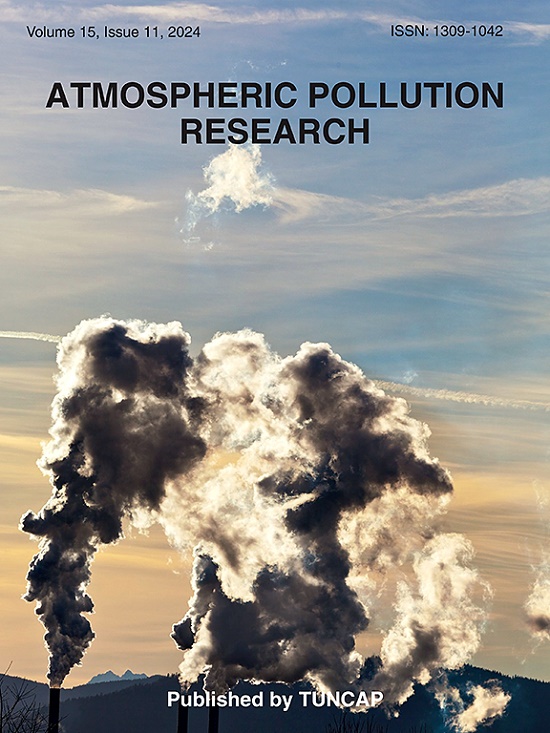空气污染与阻塞性睡眠呼吸暂停在呼吸事件频率和肺到手指循环时间方面的关系
IF 3.5
3区 环境科学与生态学
Q2 ENVIRONMENTAL SCIENCES
引用次数: 0
摘要
空气污染物暴露已被证明会加剧阻塞性睡眠呼吸暂停(OSA)的表现,如呼吸发作次数增加和间歇性氧饱和度降低。然而,大多数研究关注的是发作频率而不是持续时间。本研究通过基于频率的指数和基于持续时间的肺-手指循环时间(LFCT)来调查空气污染与OSA表现之间的关系。820例疑似OSA患者的多导睡眠图数据(轻至中度:n = 224;重度:n = 596)。睡眠障碍指标包括呼吸暂停低通气指数(AHI)、氧去饱和指数(ODI)、觉醒指数和平均LFCT。引入了一种新的复合度量,即呼吸事件反应时间面积(RERTA),定义为LFCT和AHI乘积的平方根,用于评估频率和持续时间之间的相互作用。空气污染物暴露量是利用研究队列登记住所4公里内监测站的数据进行估计的。采用多变量泊松回归模型评估短期(1个月)和长期(1年)暴露效应。短期PM2.5和NO2暴露与AHI、ODI、觉醒指数升高和LFCT降低显著相关。长期暴露于PM2.5、PM10和NO2与AHI和ODI增加有关,而PM2.5和PM10与LFCT降低有关。短期和长期臭氧暴露均与AHI和ODI升高有关。PM2.5和O3(短期)与RERTA呈正相关。这些研究结果表明,空气污染通过增加发作频率和加速代偿反应来加剧OSA,从而增加心肺负担,正如RERTA所反映的那样。本文章由计算机程序翻译,如有差异,请以英文原文为准。
Association between air pollution and obstructive sleep apnea in terms of respiratory event frequency and lung-to-finger circulation time
Air pollutant exposure has been shown to exacerbate obstructive sleep apnea (OSA) manifestations, such as increased respiratory episodes and intermittent oxygen desaturation. However, most studies have focused on episode frequency rather than duration. This study investigated the associations between air pollution and OSA manifestations using both frequency-based indices and the duration-based marker lung-to-finger circulation time (LFCT). Polysomnography data from 820 individuals with suspected OSA (mild-to-moderate: n = 224; severe: n = 596) were analyzed. Sleep disorder indices included the apnea–hypopnea index (AHI), oxygen desaturation index (ODI), arousal index, and mean LFCT. A novel composite metric, respiratory event response time area (RERTA), defined as the square root of the product of LFCT and AHI, was introduced to evaluate the interplay between frequency and duration. Air pollutant exposure was estimated using data from monitoring stations within 4 km of the registered residences of the study cohort. Multivariable Poisson regression models were employed to assess short-term (1-month) and long-term (1-year) exposure effects. Short-term PM2.5 and NO2 exposure were significantly associated with increased AHI, ODI, arousal index, and reduced LFCT. Long-term exposure to PM2.5, PM10, and NO2 was associated with increased AHI and ODI, while PM2.5 and PM10 were linked to reduced LFCT. Both short- and long-term O3 exposure were associated with increased AHI and ODI. PM2.5 and O3 (short-term) were positively associated with RERTA. These findings suggest that air pollution exacerbates OSA by increasing episode frequency and accelerating compensatory responses, thereby elevating cardiopulmonary burden as reflected by RERTA.
求助全文
通过发布文献求助,成功后即可免费获取论文全文。
去求助
来源期刊

Atmospheric Pollution Research
ENVIRONMENTAL SCIENCES-
CiteScore
8.30
自引率
6.70%
发文量
256
审稿时长
36 days
期刊介绍:
Atmospheric Pollution Research (APR) is an international journal designed for the publication of articles on air pollution. Papers should present novel experimental results, theory and modeling of air pollution on local, regional, or global scales. Areas covered are research on inorganic, organic, and persistent organic air pollutants, air quality monitoring, air quality management, atmospheric dispersion and transport, air-surface (soil, water, and vegetation) exchange of pollutants, dry and wet deposition, indoor air quality, exposure assessment, health effects, satellite measurements, natural emissions, atmospheric chemistry, greenhouse gases, and effects on climate change.
 求助内容:
求助内容: 应助结果提醒方式:
应助结果提醒方式:


